In 1907, Teddy Roosevelt ordered the US fleet deployed to the West Coast around South America as a test of its ability to fight a war with Japan. As it reached the Pacific, his administration decided to return it to the Atlantic by circumnavigating the globe. The second leg took it from San Francisco to Hawaii, New Zealand, and Australia. From Australia, the fleet set out for Manila, arriving on October 2nd to find a cholera outbreak waiting for them. All liberty was cancelled, and the fleet's main focus was on coaling, a brutal task in the heat of the Philippines. The only interruption was a typhoon, which pushed the departure back a day. Another storm struck as they made their way north to the visit at Yokohama, scattering the ships and washing a sailor overboard to his death. This prompted another day's delay, but the Japanese were able to rearrange the schedules to solve any problems this would have caused.
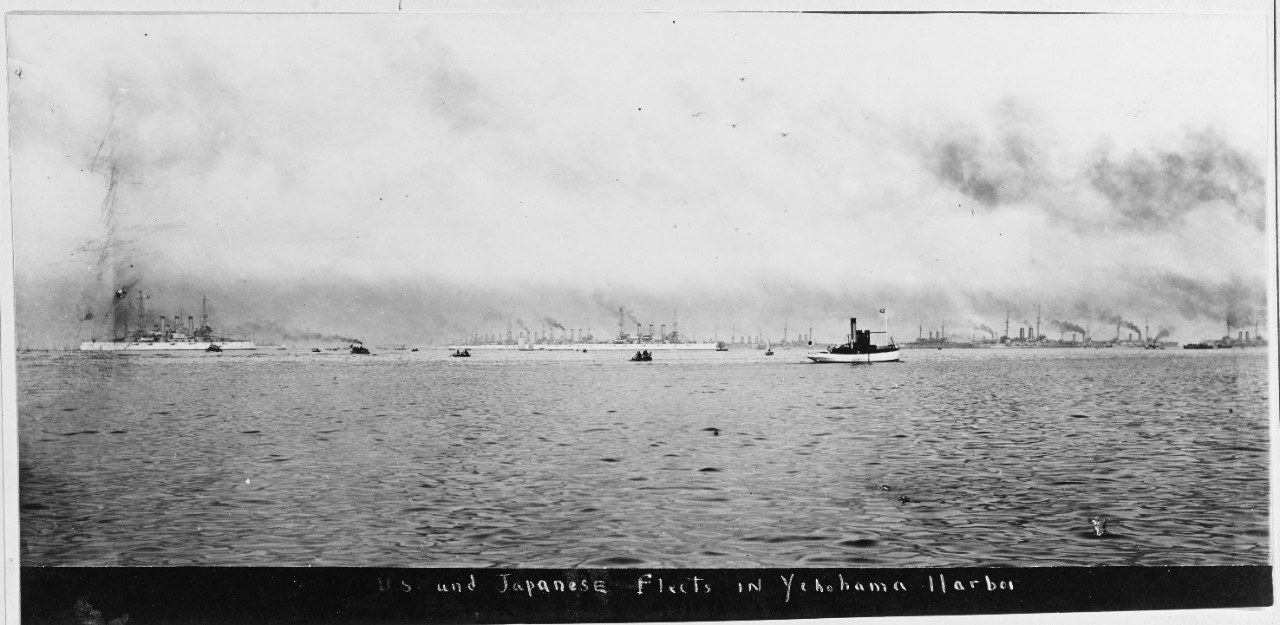
The Great White Fleet moored in Yokohama
Despite the American-Japanese tensions that had prompted the cruise in the first place, Japan pulled out all the stops for the visit, and was rewarded by a significant warming in the relationship.1 Meticulous planning resulted in a highly successful series of receptions, tours and banquets, while Admiral Sperry took great pains to ensure that his men were on their best behavior ashore. The Emperor himself joined the fleet's senior officers for a luncheon in Tokyo, where he was reportedly very good company. The only flaw in the visit was the reception thrown by the Americans aboard the Connecticut, which ran out of food before the announced start time due to an excess of visitors and a very limited catering budget. The Japanese were gracious about it, however, and their conduct went a long way to defuse the tensions built up over the previous few years. Shortly after the fleet's departure, the Root-Takahira Agreement was signed, smoothing over most of the outstanding official disputes.
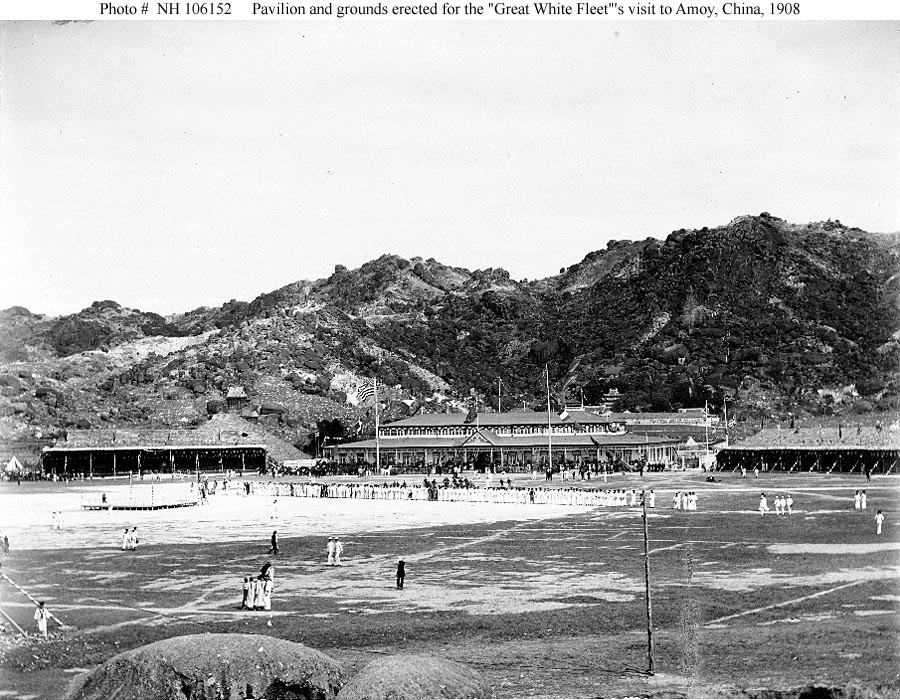
The pavilion assembled for the fleet's entertainment in Amoy.
At this point, the fleet split. The First Squadron returned directly to Manila, while the Second was to call at Amoy, in southern China. This was the most diplomatically complicated of the fleet's visits, as Germany had been trying to set up a Sino-German-American alliance,2 and the Chinese initially read American acceptance of their invitation as a good sign. It was nothing of the sort, and when the US Navy pointed out that Shanghai did not have a suitable harbor, forcing the visit to be changed to remote Amoy and half the fleet to be sent to the Philippines instead, enthusiasm among the Chinese cooled. Peking still made great efforts to welcome the Americans, although they faced apathy and even fear among the citizens of Amoy, who believed the US was planning to seize their city as a base against Japan. Despite these and other complications, including an assassination plot by Chinese revolutionaries, spats among the US diplomatic corps in China and the Germans essentially crashing the party with one of their cruisers, the visit was fairly quiet. All festivities were held in a special reception area, and there was none of the spontaneity that had marked previous port calls, but the Chinese had done a remarkably good job under the conditions they faced. Soon, though, the visit was over and Second Squadron headed for Manila to meet up with the other half of the fleet.
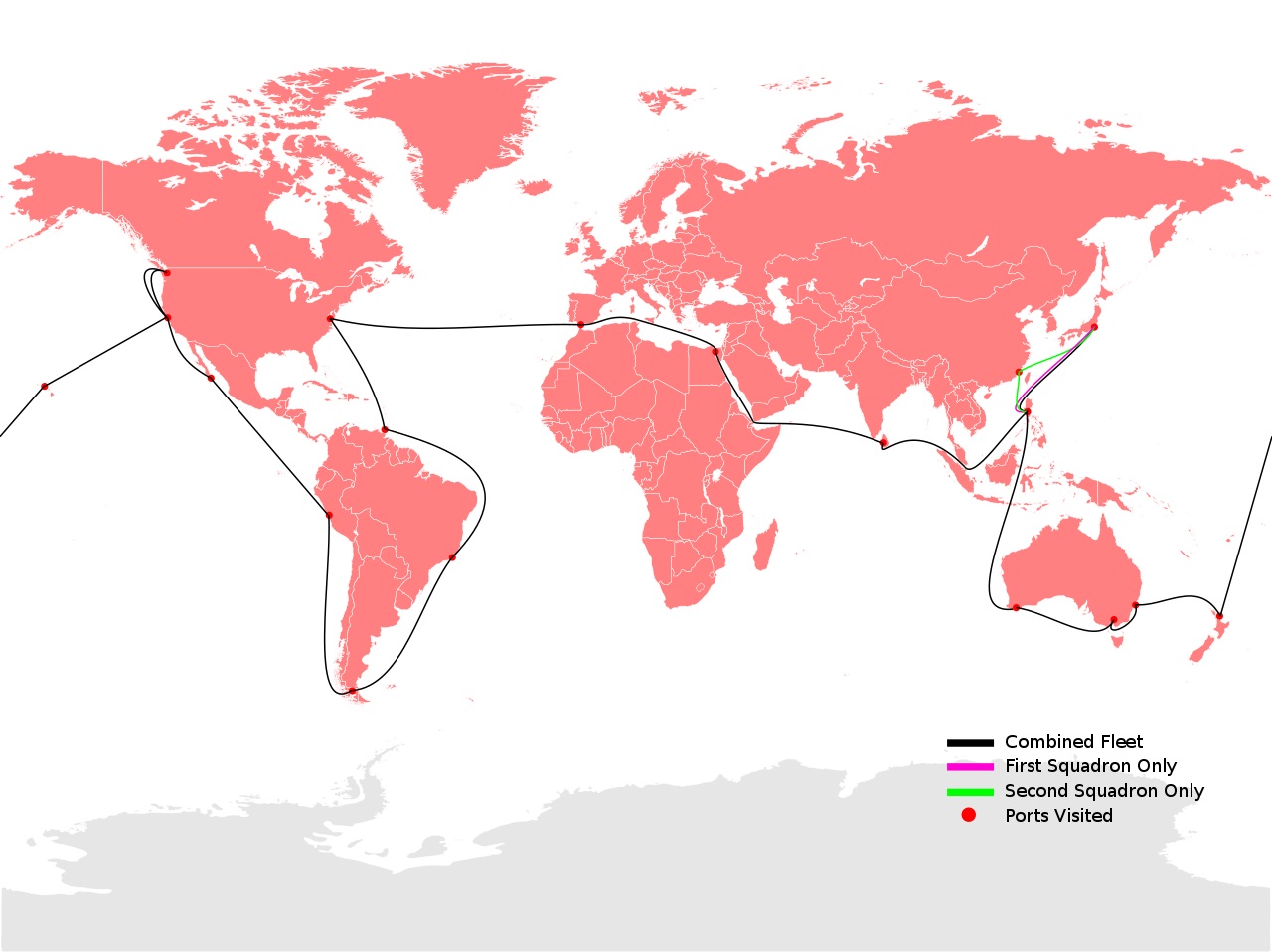
The route of the Great White Fleet
November was mostly taken up with battle practice in Manila Bay, site of Admiral Dewey's great victory a decade earlier. The cholera had abated somewhat, although Admiral Sperry was still reluctant to allow liberty parties ashore. He was essentially overruled by the Secretary of the Navy, and was fortunate that no cases of the disease made their way aboard the ship. Finally, on December 1st, the fleet left Manila. The battleships flew their 200 foot "Homeward Bound" pennants, and the officers and men were happy to be on their way back to the Atlantic. This would be a much faster transit, stopping mostly to take on coal, and not to dispense diplomacy.
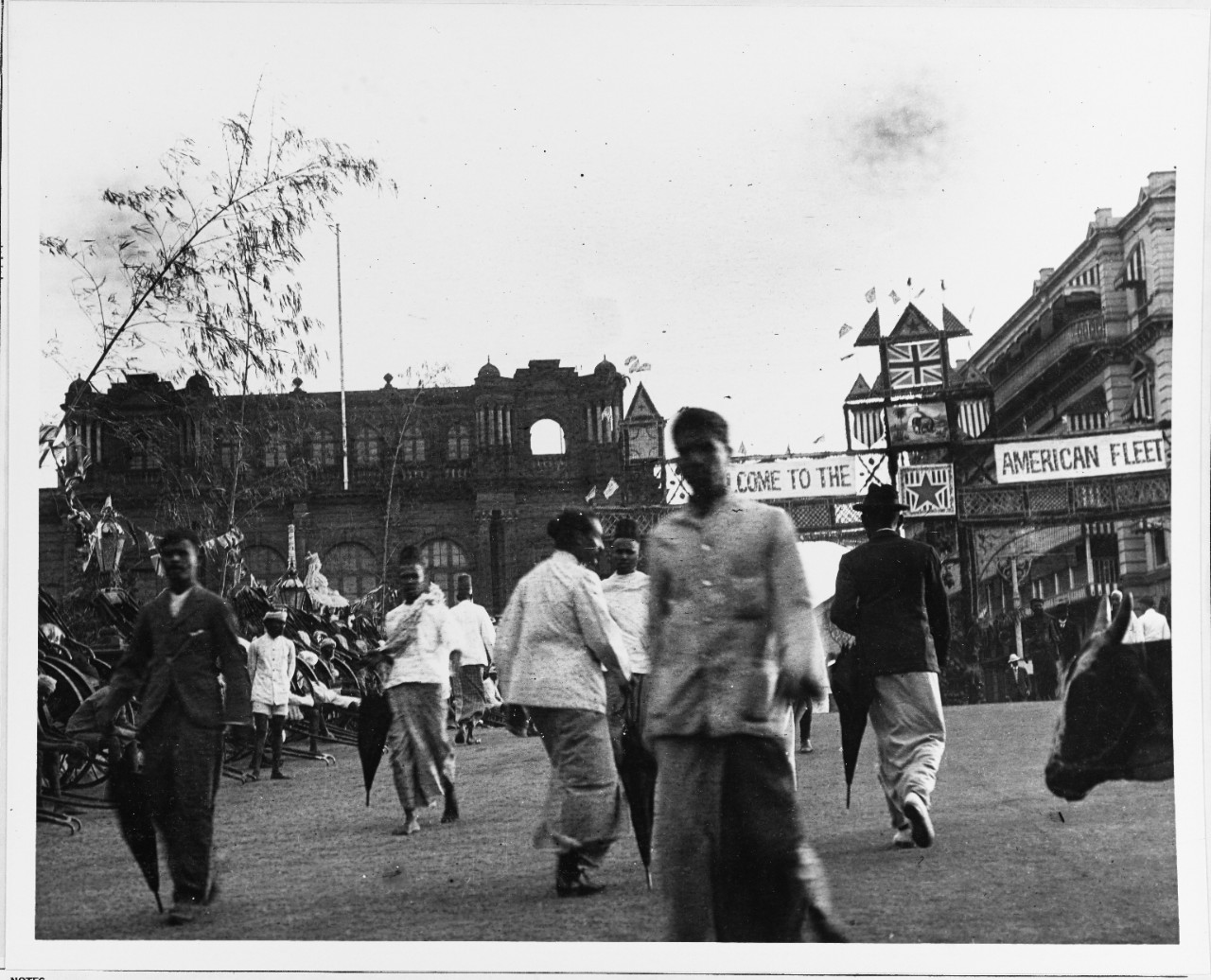
The scene ashore in Colombo
The fleet passed Singapore without stopping on December 6th, bound for Colombo in modern-day Sri Lanka. The only excitement of this leg was a man lost overboard on the 8th, and a case of smallpox discovered the next day onboard Georgia. She was sent ahead to Colombo at her maximum speed, and every man who had been ashore in Manila was promptly vaccinated. Fortunately, these measures worked, and the disease spread no further. The weather was good, and the rest of the fleet arrived late on the 12th, a full day ahead of schedule. This time, all of the colliers had arrived on schedule, and coaling went without incident. The bustling port was unlike anything the men had ever seen, and tea magnate Thomas Lipton sent the fleet off with five pounds of his product for each officer and a pound for each enlisted man.
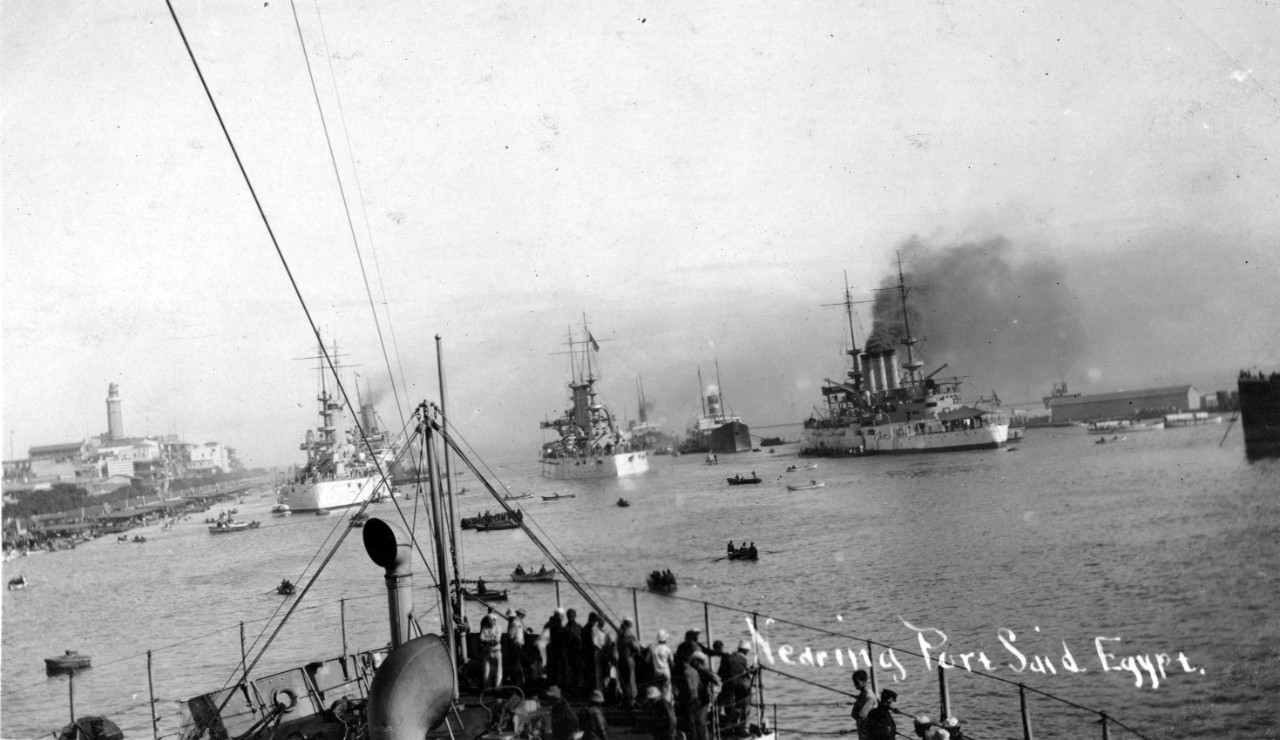
The Great White Fleet passing through the Suez Canal.
The next stop was at Suez, the southern terminus of the eponymous canal. The seas had remained calm, and the ships arrived on January 3rd, 1909, two days ahead of schedule. The fleet had planned to spend a month in the Mediterranean, making a variety of unofficial port calls in the Levant, the Balkans, Greece, Italy, Malta and France. However, an earthquake had hit Sicily a week earlier, and the fleet's stores ship was quickly dispatched to provide supplies. Sperry and his staff frantically rearranged the fleet's itinerary, while the battleships transited the canal over three days. The first two groups got through unhindered, while Georgia, leading the third, ran aground, and took two hours to get off. She was undamaged, but the delay meant that some of the ships spent the night moored in the middle of the canal. The battleships had been split up in the hopes of not overwhelming the coaling facilities in Port Said, but this effort was not successful, and the ships had to be dispatched as they were ready.
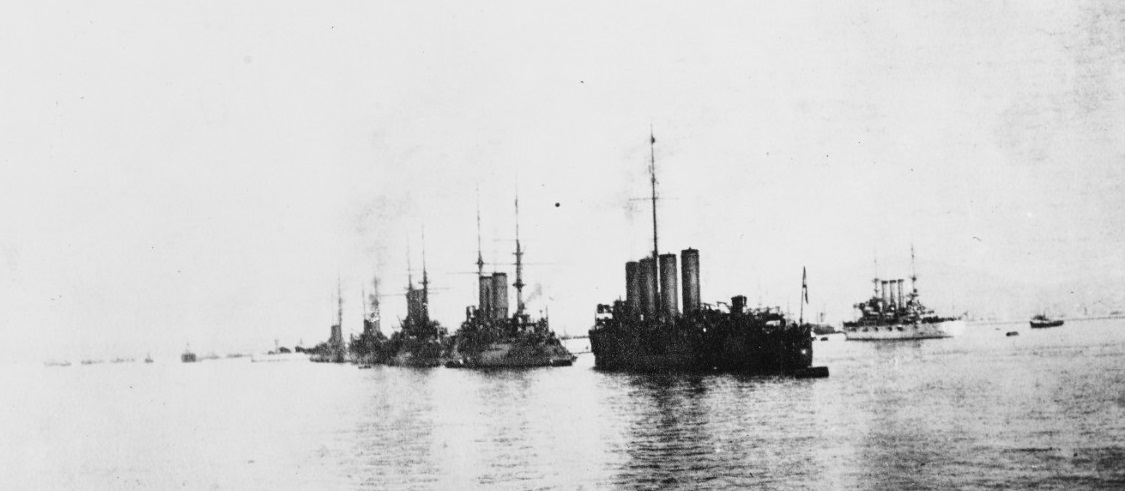
Warships responding to the Messina Earthquake. Connecticut is the white ship in the back right, while the other vessels are the Russian Mediterranean Fleet.
Sperry in Connecticut proceeded to Messina and Naples, and there spent 10 days directing the American relief operations. The only other battleship to participate was Illinois, diverted from Malta to recover the bodies of the American consul in Messina and his wife. The rest of First and Second Divisions had liberty on the French Riveria, at Villefranche and Marseilles respectively. They received a warm (if unofficial) reception, and many officers took the chance to tour France and Italy. Two ships of the Second Division were forced to leave a day early to pay a visit to Tangier, to underscore the US recognition of the new Sultan of Morocco. Third Division was split, two ships proceeding to Beirut, where they cancelled a visit due to plague, and then to Smyrna, Turkey. There they were joined by the other two vessels, who had called at Athens and Salonika. Fourth Division was assigned the south shore of the Med. Wisconsin and Kearsage visited Malta, where Illinois caught up with them a few days later. Kentucky visited Tripoli,3 then all four ships rendezvoused at Algiers for a week of liberty and sightseeing.

When the fleet reassembled in Gibraltar, two of the ship's captains were relieved from duty. The Captain of Georgia had appeared falling-down drunk at a reception in Tangier, while Kentucky's had suffered a nervous breakdown. This was ultimately the result of the USN's policy of promoting by strict seniority, which meant that by the time men were old enough to command, many of them were physically unfit to do so. The mornings in Gibraltar brought some humor, as ships of five navies were moored in the harbor. During morning colors, the band of each ship first played its own anthem, then the anthems of the other navies. The resulting cacophony lasted 10 or 15 minutes and reverberated from the walls of the narrow basin. The only serious complication was the matter of stores. All of the supplies originally intended for the fleet had been dispersed to the victims of the earthquake, and the ship dispatched with more had been sunk in a collision. Sperry's staff quickly arranged more to be purchased in Marseilles, and put aboard the fleet's tenders.

Battleships Maine, New Hampshire, and either Mississippi or Idaho greet the Great White Fleet
At last, on February 6th, 1909, the ships weighed anchor and headed across the Atlantic, bound for Hampton Roads. The Atlantic crossing was the roughest yet, with massive storms washing away boats on several of the battleships. Eleven days later, they were joined by the four battleships that had remained in the Atlantic, which prompted some comment. The orders to switch the paint scheme from white to grey had already been implemented for stateside ships, and two of the vessels had the new lattice masts, which one sailor claimed made them look like oil rigs.

Mayflower (left) reviews the ships of the fleet
At 11 AM on February 22nd, the fleet reentered Hampton Roads in triumph. President Roosevelt, in the waning days of his administration, reviewed them from his yacht, the Mayflower. Each ship fired a 21-gun salute to him as it passed, and the crowds, both ashore and in boats, kept up a steady roar. It was a triumph for the man who had built the fleet, despite the rainy weather. After the ships were in port, he went aboard each divisional flagship to address the men, formally bringing the cruise to a close. The vessels would disperse in March, some to be painted and fitted with lattice masts, others to be placed in reserve, but not until they had provided men for Taft's inaugural parade on March 4th.
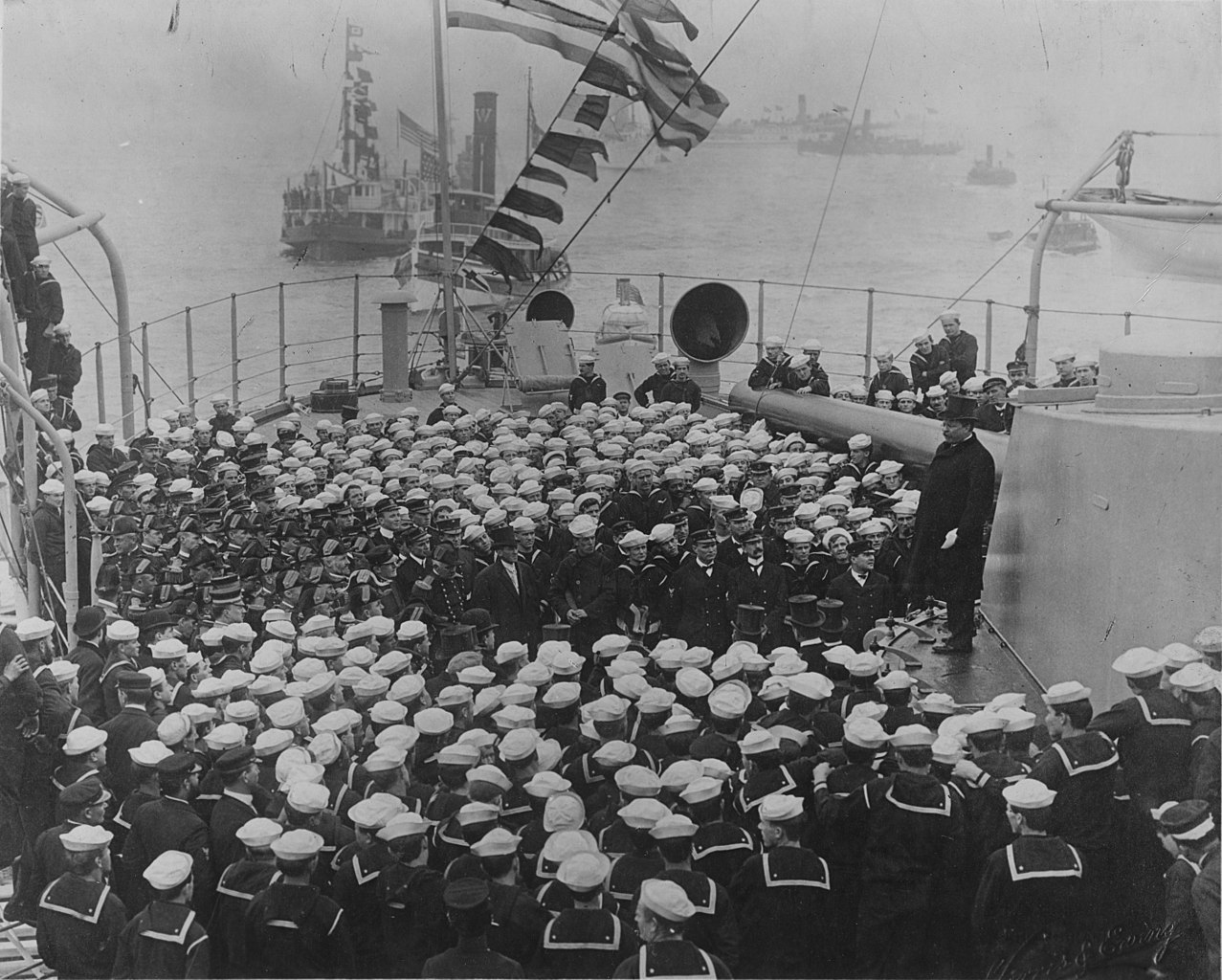
Roosevelt speaking aboard Connecticut
The Great White Fleet was a seminal moment in the history of the US Navy. Never before had any Navy sent a fleet of such size around the world, nor had it arrive home in better condition than it left in. What started as a cruise to see if the fleet could avoid the fate of the Russians at Tsushima had turned into a diplomatic triumph for the United States, and also the trigger for serious reform of the Navy, most notably in the design of future battleships. It was a fitting memorial for a man who had done more than any other to make the USN a world-class force, a status it has retained ever since.
1 Contrary to some accounts, there was never a serious plan by either side to attack during late 1908, nor was either power worried about such an attack by the other. ⇑
2 No, I don't really understand this either. Germany diplomacy in this era was insane. ⇑
3 The one in modern Libya, not modern Lebanon. This is also the Tripoli that appears in the Marine Corps hymn. ⇑

Comments
I sort of see the logic in it. Britain and Russia are the two powers Germany would have the most trouble fighting. A strong China would force Russia to keep an Army in the far east. The problems the USA could cause for Britian don't need saying. As a bonus, the USA is already the great power most committed to Chinese survival. The big downside is that there isn't much in it for the Americans if Britain/Japan aren't stirring up trouble.